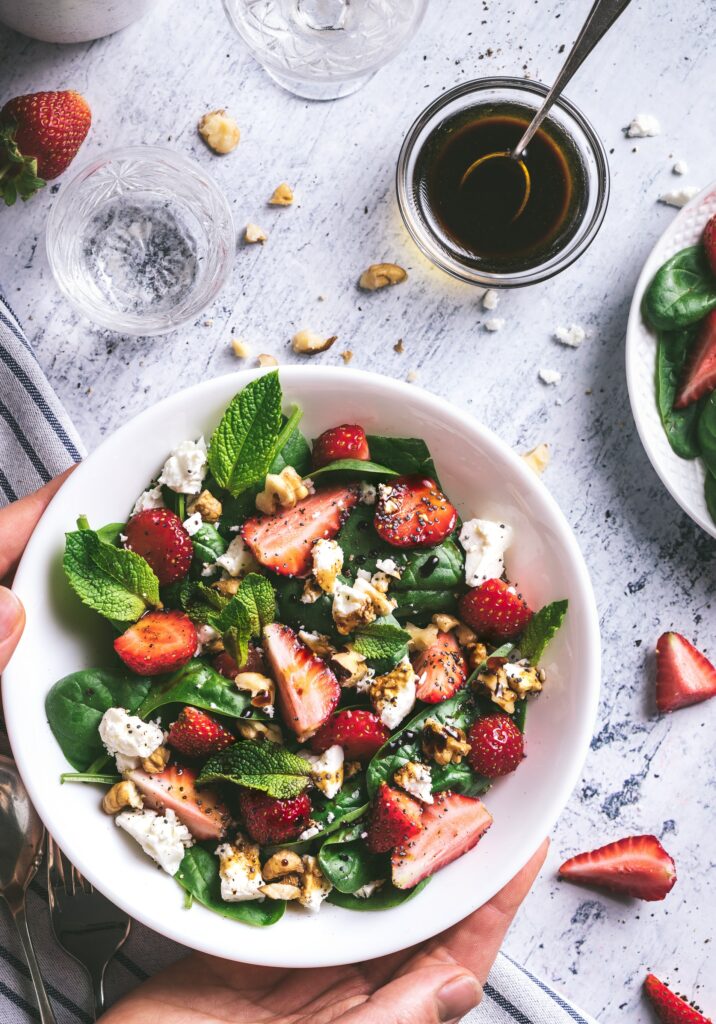Notice a daily crash in your energy? Crave sugar every afternoon? Recently diagnosed with PCOS? If so, you’re not alone. In many cases, the root cause lies in metabolic health—aka, blood sugar instability. Interestingly, only a small percentage of the U.S. population is metabolically healthy. Meaning, most of us are walking around with unstable blood sugar! And stable blood sugar is key for almost all human functions—sustained energy, cognitive function, hormone health, and more. Today, we’re diving into all things blood glucose. Specifically, sneaky things that can cause blood sugar spikes. Knowledge is power.

what is blood sugar?
Blood sugar—also known as blood glucose—refers to the concentration of glucose (a type of sugar) present in the bloodstream. It’s our primary source of energy! And we get it from breaking down carbohydrates. Furthermore, blood sugar is regulated by the hormone insulin. This is produced by the pancreas.
Why is blood sugar balance important?
As often as possible, you want to keep your blood sugar levels in your target range. You can easily do this wearing a continuous glucose monitor! This helps prevent or delay long-term, serious health problems. Think: heart disease, vision loss, kidney disease, and unwanted weight gain. On a day-to-day basis, staying in your target range is also equally important. It can improve your energy, balance hormones, and stabilize your mood.

What Are normal Blood Sugar Levels?
A normal blood sugar range will vary. For someone who hasn’t eaten or drank anything besides water (also known as the “fasted state”), normal blood sugar is below 100 mg/dL. Anything at or above 100 mg/dL is considered borderline high, and a fasting blood sugar of 126 mg/dL or higher is often indicative of diabetes.
In a non-fasted state, blood sugar should be between 70-130 mg/dL, and should fall below 140 mg/dL two hours after eating a meal. You can learn about your specific blood sugar response, here.
Low blood sugar, or hypoglycemia, occurs when blood sugar levels fall below 70 mg/dL, and any blood sugar spikes over 200 mg/dL is considered very high, regardless of the time or respect to eating. If you want to start testing your blood sugar at home, this is the glucometer kit I recommend.
What factors impact bood sugar leves?
Many. Food, activity, stress, and illness can affect your blood sugar levels. Genetics also plays a role. Those with a family history of prediabetes (or diabetes) are at higher risk of having elevated blood sugar. Besides family history, some risk factors for prediabetes and type 2 diabetes include:
- Being overweight
- Age 45 or older
- Having a sedentary lifestyle
- A history of gestational diabetes or polycystic ovarian syndrome (PCOS) in women
- Race (African Americans, Hispanic/Latino Americans, American Indians, Pacific Islanders, and some Asian Americans are at higher risk)
However, the benefits of healthy eating and exercise are well-established. They’re often the first line of defense to help lower blood sugar levels. Consistently eating a diet high in refined carbohydrates and sugar raises blood sugar levels. Unfortunately, added sugar is in just about everything—from condiments to sauces, crackers, granola bars, cereal, and more—and it’s a culprit for raising blood sugar. Refined sugars are rapidly digested and converted into glucose. In turn, spiking blood sugar.

4 Tips to help manage blood sugar levels
Before we dive into sneaky things that cause blood sugar spikes, below are four tips to help you manage your blood sugar.
1. Pair carbs with protein or fat
This will help slow the rate of sugar entering your bloodstream. A few examples: A handful of nuts with a piece of fruit, crackers with cheese, and eggs, turkey sausage, avocado, etc. with your morning toast. In essence, adopting a diet that is rich in fiber and protein can promote healthy blood sugar levels. If you’re new to understanding carb intake, let’s work together! When it comes to balancing blood sugar spikes, having a health coach, nutrition consultant, or RD—to provide nutritional support—is key.
2. Stay hydrated
Water reduces blood sugar by diluting the amount of sugar in the blood. Aim for filtered water with electrolytes (this powder is delicious and has no sugar added).
3. Move your body
Being physically active also helps to reduce insulin resistance and lower blood sugar. Muscles use up extra blood glucose during exercise, which is why resistance training is so beneficial. However, never underestimate the advantages of walking!
4. Get quality sleep
Too little sleep causes cortisol to rise, thus causing blood sugar to rise as well. Keep in mind that sleep and glucose have a bi-directional relationship. In one direction, how well or poorly you sleep will directly impact your glucose levels. In the other direction, what your glucose levels are like going into the night will impact your sleep.

10 surprising blood sugar triggers
While there are general factors that can send your blood sugar soaring, it’s also helpful to know sneaky things that can cause blood sugar spikes.
Caffeine
Some people are extra-sensitive to caffeine (you might feel an intense adrenaline rush, get the jitters, feel very anxious, have a headache, etc.). While coffee may impact insulin levels, more research is necessary. To avoid blood sugar spikes from caffeine, be sure to eat breakfast before and ideally add a source of healthy fat, unsweetened milk, and / or protein to your coffee.
Skipping breakfast
Speaking of breakfast, skipping your morning meal can do more harm than good for your blood sugar levels. When you skip breakfast, you’re running on cortisol, which will spike blood sugar through lunch (and potentially dinner). The goal is to eat intuitively and honor your hunger, but consider whether you’re intentionally suppressing your appetite in the morning.
Artificial sweeteners
Studies show that artificial sweeteners are not only inflammatory, but they can raise blood sugar levels.
Dried Fruit
Whole fruit is a healthy choice, but dried versions pack more carbohydrates in a smaller serving size. For example, two tablespoons of dried cranberries have very similar carbs to a small piece of fruit. Ideally, combine dried fruit with raw nuts, coconut flakes, pumpkin seeds, and dark chocolate (for a DIY, blood sugar-friendly trail mix).
Inflammatory oils
Opt for anti-inflammatory oils, instead! We’re inundated with inflammatory oils in salad dressings, packaged goods, sweets, and more. Unfortunately, inflammatory foods—including oils like soybean oil and canola oil—affect our cells. It makes them insulin resistant, leading to chronically elevated blood sugar levels.
Sunburn
Interestingly, very hot temperatures, along with getting a painful sunburn, can significantly affect your blood sugar levels. For example, extreme heat can cause blood vessels to dilate, which makes insulin absorb more quickly and could lead to low blood sugar.
Dehydration
Not only does spending long hours in the sun potentially cause a spike in blood sugar, but it can lead to dehydration, too. And dehydration also leads to higher blood sugar concentration. We need to be adequately hydrated to manage blood sugar.
Lack of sleep
Even partial sleep deprivation (over one night) increases insulin resistance, which can in turn increase blood sugar levels. As mentioned, sleep and glucose have a bi-directional relationship. Sleep directly impacts your glucose levels, but your pre-bed glucose levels will also impact your sleep.
Gum disease
Much like sleep, blood sugar imbalance leads to higher blood sugar (glucose) levels in your mouth’s fluids. This promotes the growth of bacteria that can cause gum disease. Additionally, infections from untreated periodontal disease can cause the blood sugar to rise and make it harder to control diabetes.
Illness
Did you know your blood sugar rises as your body works to fight off an illness? Drink water and other fluids, like bone broth, to stay hydrated. Be aware that some medicines, such as antibiotics and decongestants that clear sinuses, can affect your blood sugar.
Ready to tap into your specific blood sugar response? Click here to skip the line and start wearing a continuous glucose monitor *and* get two months of a free membership!

Images courtesy of Unsplash.
This article contains affiliate links. Thank you for supporting Wellness with Edie!
This article is for informational purposes only. It is not, nor is it intended to be, a substitute for professional medical advice, diagnosis, or treatment and we recommend that you always consult with your healthcare provider.



Leave a Reply